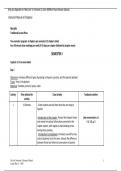(Hoy día Spanish for Real Life 1e (Volume 2) John McMinn Nuria Alonso García)
(Instructor Manual all Chapters)
Hoy día
Traditional Lesson Plans
Two‐semester program: 6 chapters per semester (12 chapters total)
Four 50‐minute class meetings per week (9‐10 days per chapter followed by chapter exam)
SEMESTER I
Capítulo 1: En la universidad
Day 1
Objectives: Introduce different types of greeting in Hispanic countries, and the Spanish alphabet
Topics: Tema 1 Vocabulario
Materials: Textbook, pictures/ props, video
Activity Time allotted for Class Activity Textbook activities
activity
1 15 Minutes ‐ Greet students and ask them how they are doing in
Spanish.
‐Introduction to the chapter. Present the chapter theme Una conversación and
and review the cultural information presented in the 1‐1; 1‐3, p. 5
chapter opener, with regards to hand‐shaking versus
kissing when greeting.
‐ Introduction to Vocabulario. Introduce yourself to class
and ask students to do the same. Indicate the difference
between formal and informal conversation in Spanish,
Hoy día Instructor’s Resource Manual 1
Lesson Plan A – CH01
, using tú and usted.
‐ Objectives: Introduce the 2 main points of today’s class
and its objectives, as stated on the syllabus then,
proceed to practice greetings and leave‐takings with
students. Mention that there is a formal and informal
level of conversation in Spanish, depending on the
relationship between people. Example: 1. ¿Cómo te
llamas (tú)? vs. ¿Cómo se llama (usted)?
‐ Oral & Written Practice: Activity Una conversación and
1‐3 Otra conversacíon. Because of time constraints, the
instructor may want to mention in the previous class
that Una conversación should be studied before coming
to class, therefore, the new vocabulary and grammatical
structures are clear.
2 10 Minutes ‐ Introduce the Spanish alphabet. Emphasize the 1‐2, p. 5
particular sounds of the letters r, ll, and h (which is
silent).
Oral & Written Practice: Have students listen and repeat
every single vowel and consonant.
‐ You may write a few selected Spanish words from the
new vocabulary on the board, and ask the students to
spell them.
Hoy día Instructor’s Resource Manual 2
Traditional Lesson Plans
, 3 10 Minutes Communicative Exercise: You may consider using the
conversation model Una conersaciónon p. 5, so students
can create their own script and practice greetings and
spelling.
‐ While spelling, pay attention to students’
pronunciation.
4 5 Minutes Assessment on written exercises: Correct the assigned
written activities on the syllabus, and collect the
assignments.
5 5 Minutes Listening Comprehension: Assign ¡A escuchar! with
books closed then, with books opened to assess ¡A escuchar!
students’ listening and comprehension skills.
6 5 Minutes ‐ Final Summary: Review the ¿Sabías que? and ¡Ojo!
boxes, and explain the cultural differences between
Hispanics and non‐Hispanics when the greet.
‐ Review the spelling of the new vocabulary that is
written on the board. Ask students if they are clear and if
they have any questions.
‐ Take‐leave in Spanish, and remind them to follow the
instructions on the syllabus, and have their assignments
completed before coming to class.
Homework:
1. Instructors may remind their students that they should plan on studying at least two hours for every hour in class. Students may
be advised that they are expected to do all the activities before coming to class, as stated earlier on the syllabus.
Hoy día Instructor’s Resource Manual 3
Lesson Plan A – CH01
, 2. Instructors may also advise their students to follow up with the contents and requirements of the syllabus, as stated for each day
of the week.
3. Do SAM: 1‐1 to 1‐6, pp. 1‐3
Day 2
Objectives: Address people in formal and informal ways (tú / usted), and use the verbs ser and estar
Topics: Tema 1. Gramática 1, Gramática 2
Materials: Textbook, pictures/ props, video
Activity Time allotted for Class Activity Textbook activities
activity
1 15 Minutes ‐ Greet students and ask them how they are doing in Spanish.
‐ Introduction to Gramática 1: Introduce the familiar and the formal
contexts with tú and usted. Write on the board the following
questions: 1. ¿De dónde eres Pili? 2. ¿De dónde es usted, Sr.
Presidente?
‐ Objectives: Introduce the main points of today’s class and its
objectives, as stated on the syllabus. Answer the first question Soy de
San Juan, Puerto Rico y, ¿tú? Mention that the first question entails
an informal conversation, while the second question is directed in a
formal mode, because of the subject’s authority: Soy de México
‐ Explain to students that these differences are manifested much
more in Spanish than in English. In English, there is no difference
Hoy día Instructor’s Resource Manual 4
Traditional Lesson Plans




